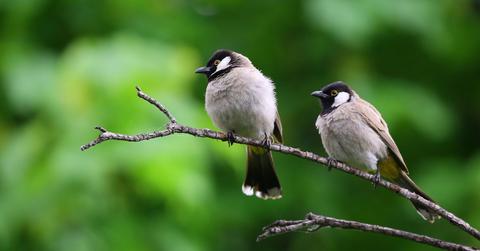This Device May Save Birds Endangered By Wind Energy Towers
As human structures get in their flight paths, there is a more desperate need for a way to protect the birds without shutting down wind energy ventures. These scientists think they have a solution.
Updated May 22 2019, 12:37 p.m. ET
Though wind energy is becoming more popular all the time, and surpassing expectations for its energy-producing capabilities, there are still some drawbacks that attract opposition. For nature lovers, a fear of the possible consequences of giant towers going up in the flight path of beloved birds has been a huge issue. Popular Science reports that researchers at the College of William & Mary have come up with an innovative device to warn birds of an approaching obstacle as they fly. The Acoustic Lighthouse warns flying birds to swerve out of the way, potentially saving thousands a year.
Biologist John Swaddle spoke to the issue at the annual meeting of the American Association for the Advancement of Science, saying, "There’s a lot of interest in developing near-shore or offshore wind energy. Putting large, rotating structures that look like mincemeat-makers in the sky isn’t going to be good for the birds."
There is some debate about how many birds are killed through collisions with turbines every year; Secretary of the Interior Ryan Zinke claimed the number to be about 750,000, but that was proved to be false. It's closer to 350,000, which is still too many for biologists and bird watchers.
Basically, birds have historically not had an issue with having their eyes on the sides of their heads, and flying straight and fast forward. Most objects aren't as high as a bird—until humans came along and started building. It's not just wind turbines. Birds collide with skyscrapers, cell phone towers, and monuments built to a height higher than the average tree. Many wind farms are going up in areas where bird flight is common during migration periods.
The Acoustic Lighthouse would sense the approach of a bird, then emit a high-pitched sound that would make birds slow down. Birds basically stop their flight path by pointing their tail feathers down. This shifts their body upright, which could make all the difference. Even if they do collide with the turbine, they'll be far less likely to hit their heads, which is the cause of fatal injuries amongst birds. That could makes all the difference.
It also makes them look ahead instead of down at the ground.
“It’s a bit like someone texting while they’re driving,” said Swaddle. “If you honk your horn at them, they’ll look up.”
Swaddle has been working on the Acoustic Lighthouse with graduate student Nicole Ingrassia, testing the technology on captive zebra finches. The finches were sent down a long corridor with a mesh net at one end. Most slowed down substantially and several stopped entirely. They believe the project could be easily scaled up and implemented at building sites.
“If you want to apply this to a building or to a wind turbine, that kind of free-flying situation, you’d project the sound field 50 or maybe 100 meters in front,” explained Swaddle. “So when a bird enters that zone, it gets plenty of warning.”
The Lighthouses would also be attached at some distance from the ground, so the sound shouldn't be a problem for humans. As Swaddle points out, people aren't going to "stop using energy," and one of the most significant dangers to birds isn't collision. It's climate change. Finding a way for clean energy and wildlife to co-exist is the best bet for all our futures.
